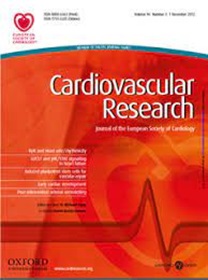RNA interference versus antibody-based PCSK9 inhibition for the prevention of cardiovascular disease: A drug-target Mendelian randomization study
IF 13.3
1区 医学
Q1 CARDIAC & CARDIOVASCULAR SYSTEMS
引用次数: 0
Abstract
Aims RNA interference therapies targeting liver expression of the gene proprotein convertase subtilisin/kexin type 9 (PCSK9) lower low-density lipoprotein cholesterol (LDL-C) and apolipoprotein B (apoB) levels. As opposed to monoclonal antibodies, which neutralise PCSK9 circulating protein, their effect on atherosclerotic cardiovascular disease (ASCVD) outcomes is unknown. We used genetic variants in the PCSK9 locus influencing PCSK9 function or gene expression in the liver to determine whether antibodies against PCSK9 and RNA interference therapies could have comparable effects on ASCVD. Methods and results We performed genome-wide genotyping and RNA sequencing of 504 human liver sample and identified a genetic variant (rs472495) explaining 5.6% of liver PCSK9 gene expression to mimic lifelong RNA interference of PCSK9. We used the PCSK9 R46L variant, known to alter PCSK9 function, to model antibody-based PCSK9 inhibition. For each standard deviation decrease in apoB levels, both variants were similarly associated with coronary artery disease risk: (OR = 0.40 [95% CI: 0.31-0.51], p = 3.7e-13 for rs472495 which affects liver PCSK9 expression) and (OR = 0.48 [95% CI: 0.43-0.55], p = 1.3e-28 for R46L which affects protein levels). Comparable effects of these two genetic inhibition approaches were observed for aortic stenosis, heart failure, ischemic stroke, type 2 diabetes and glycemic traits as well as non-alcoholic fatty liver disease and liver enzymes. Conclusions For a given reduction in apoB levels, genetically predicted reductions in PCSK9 function (mimicking PCSK9 neutralizing antibodies) and liver PCSK9 gene expression levels (mimicking PCSK9 RNA interference) were comparably associated with a lower risk of coronary artery disease. These genetic data suggest that LDL-C/apoB reductions may provide cardiovascular benefits, regardless of how PCSK9 function is inhibited.RNA干扰与基于抗体的PCSK9抑制预防心血管疾病:一项药物靶向孟德尔随机研究
目的:通过RNA干扰治疗降低肝脏低密度脂蛋白胆固醇(LDL-C)和载脂蛋白B (apoB)水平。与中和PCSK9循环蛋白的单克隆抗体相反,它们对动脉粥样硬化性心血管疾病(ASCVD)结局的影响尚不清楚。我们使用影响PCSK9功能或肝脏中基因表达的PCSK9位点的遗传变异来确定抗PCSK9抗体和RNA干扰疗法是否对ASCVD具有可比的效果。方法与结果对504份人类肝脏样本进行了全基因组分型和RNA测序,发现了一个基因变异(rs472495),该变异解释了5.6%的肝脏PCSK9基因表达,模拟了PCSK9的终身RNA干扰。我们使用已知可改变PCSK9功能的PCSK9 R46L变体来模拟基于抗体的PCSK9抑制。对于apoB水平的每个标准差降低,这两种变异与冠状动脉疾病风险相似:(OR = 0.40 [95% CI: 0.31-0.51],影响肝脏PCSK9表达的rs472495 p = 3.7e-13)和(OR = 0.48 [95% CI: 0.43-0.55],影响蛋白质水平的R46L p = 1.3e-28)。这两种基因抑制方法对主动脉瓣狭窄、心力衰竭、缺血性中风、2型糖尿病和血糖特征以及非酒精性脂肪肝和肝酶的影响相当。对于给定的载脂蛋白ob水平降低,遗传预测的PCSK9功能(模拟PCSK9中和抗体)和肝脏PCSK9基因表达水平(模拟PCSK9 RNA干扰)的降低与冠状动脉疾病的风险降低具有相当的相关性。这些遗传数据表明,无论PCSK9功能如何被抑制,LDL-C/apoB降低都可能对心血管有益。
本文章由计算机程序翻译,如有差异,请以英文原文为准。
求助全文
约1分钟内获得全文
求助全文
来源期刊

Cardiovascular Research
医学-心血管系统
CiteScore
21.50
自引率
3.70%
发文量
547
审稿时长
1 months
期刊介绍:
Cardiovascular Research
Journal Overview:
International journal of the European Society of Cardiology
Focuses on basic and translational research in cardiology and cardiovascular biology
Aims to enhance insight into cardiovascular disease mechanisms and innovation prospects
Submission Criteria:
Welcomes papers covering molecular, sub-cellular, cellular, organ, and organism levels
Accepts clinical proof-of-concept and translational studies
Manuscripts expected to provide significant contribution to cardiovascular biology and diseases
 求助内容:
求助内容: 应助结果提醒方式:
应助结果提醒方式:


